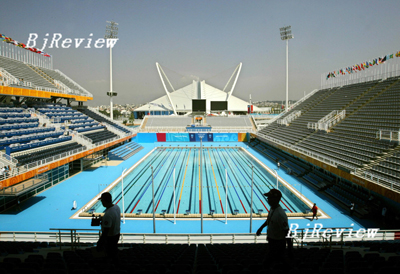
Now that the bell of the 2008 Beijing Olympic Games is soon to ring, people at home and abroad have been focusing increasingly on the construction of China's sport fields and stadiums. Many of the stadium designs, such as the famous National Stadium and National Swimming Center, nicknamed "Birds' Nest" and "Water Cube," are combining miracles of sports and architecture.
The National Stadium, known as the "Bird's Nest," will hold 100,000 fans, and leads the list of top 10 most important architectural projects under construction in the world, according to the British London Times newspaper. Construction of the National Stadium has cost a total of 3.15 billion yuan, or about $420 million.
A total of 37 stadiums in six cities are being erected for the Beijing Olympic Games, and China has invested over $2 billion on stadium construction. By the end of this year, all 36 stadiums except the National Stadium will be finished, according to the Beijing Organizing Committee for the Games of the XXIX Olympiad (BOCOG).
This grand investment for just 15 days of Olympic events could turn into a great waste of labor, resources and money if the stadiums are not properly utilized after the Games. Turning these stadiums into sustainable facilities, usable after the crowds have come and gone, is the most crucial future problem facing officials who have invested these resources.
Learning from the past
What to do with sports fields and stadiums post-Olympics is a common problem faced by countries who have hosted the Olympics before.
Soon after successfully hosting the Athens Olympics in 2004, Greece found itself in a mess of trouble. The stadiums and facilities they had constructed were in disrepair because of poor management. Only a year after the Olympics, Athens paid 100 million euro to maintain these facilities. This cost is about average for basic annual maintenance expenses. Before that, Greece had already spent $12 billion building the facilities and operating them during the games. It's no wonder that officials there warned cities hoping to host future Olympics that they should first draw lessons from what happened in Athens.
Many of the sports fields and stadiums left over from the Sydney Olympics in 2000 are no longer in use due to the relatively small size of Australia's population. Officials in Sydney announced in August 2002 that they planned to disassemble some of the Olympic facilities within the next 10 years since it costs $32 million every year just to maintain them.
Many host cities for the Olympics have seen a post-Olympics gloom, witnessing slow economic development and sometimes a backsliding in economic growth. Experts analyze that this is due to the massive investments on construction, infrastructure and management without understanding the demands of the facilities after the Olympic Games. One reason is that usage of some of these facilities is sport specific and other uses cannot be made of them after the athletes step off the podiums. Because of this, many facilities stand empty and deserted and all the investments made on them seem to have been in vain.
| 